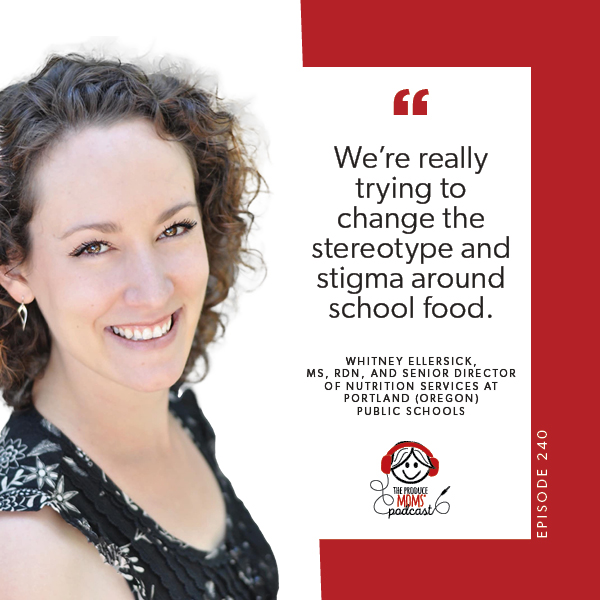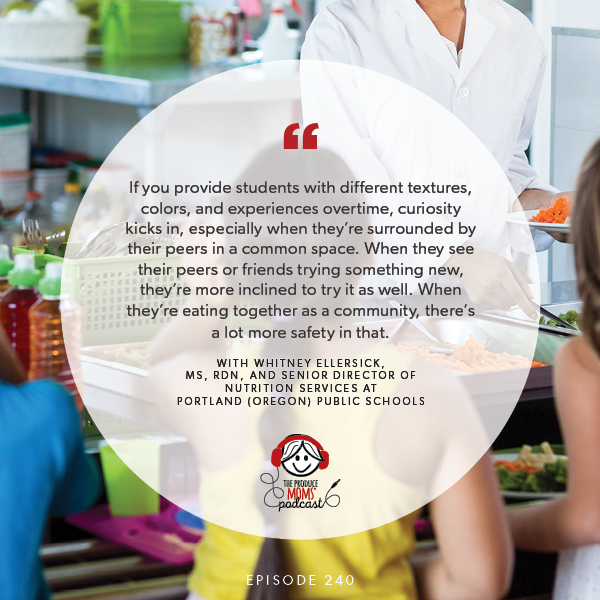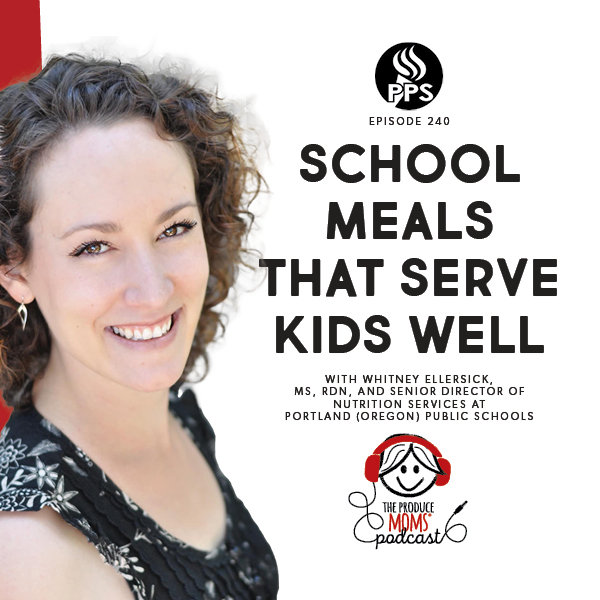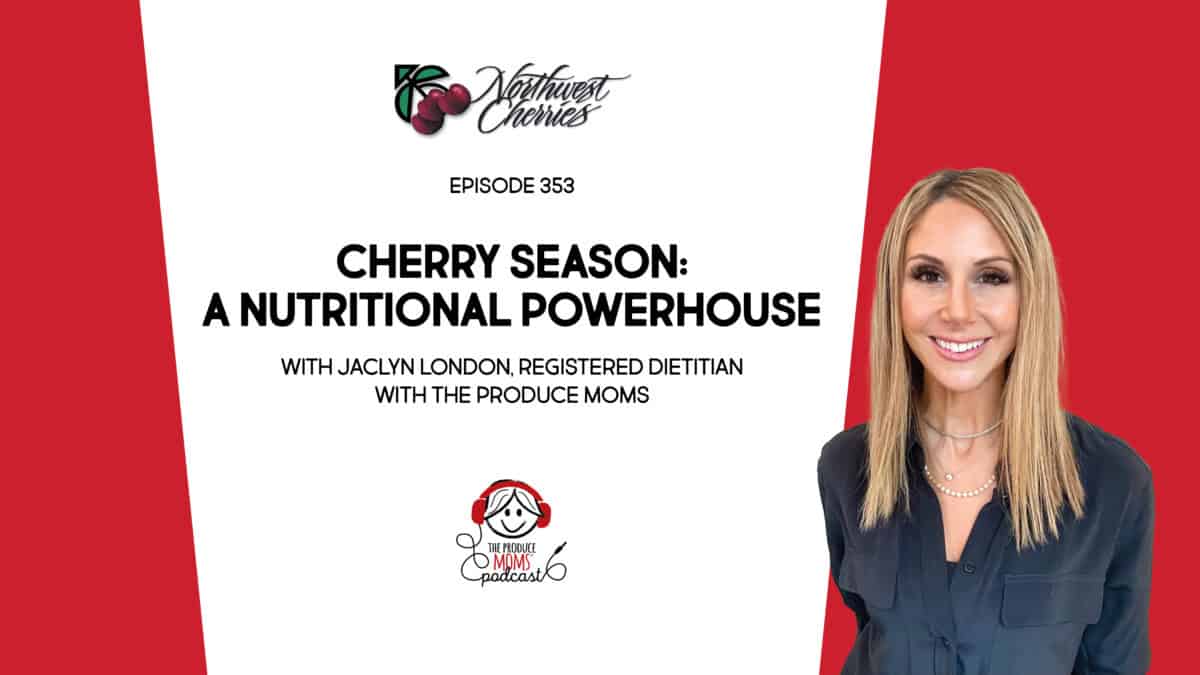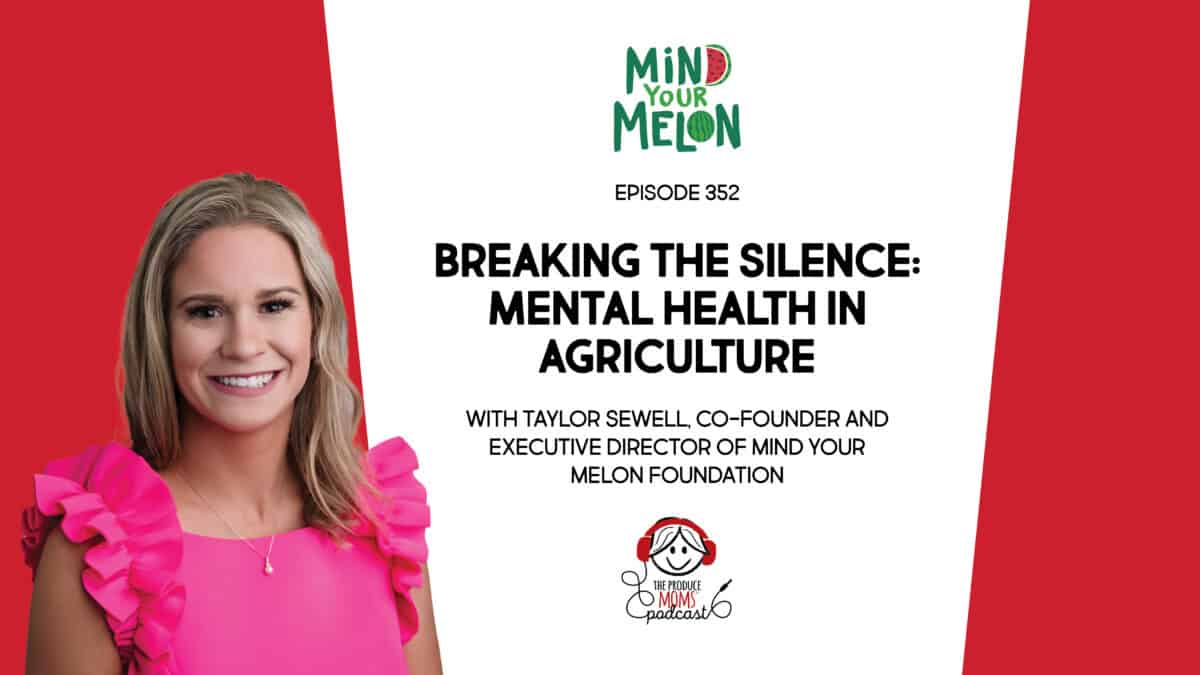Episode 240: Whitney Ellersick
Nov 09, 2022
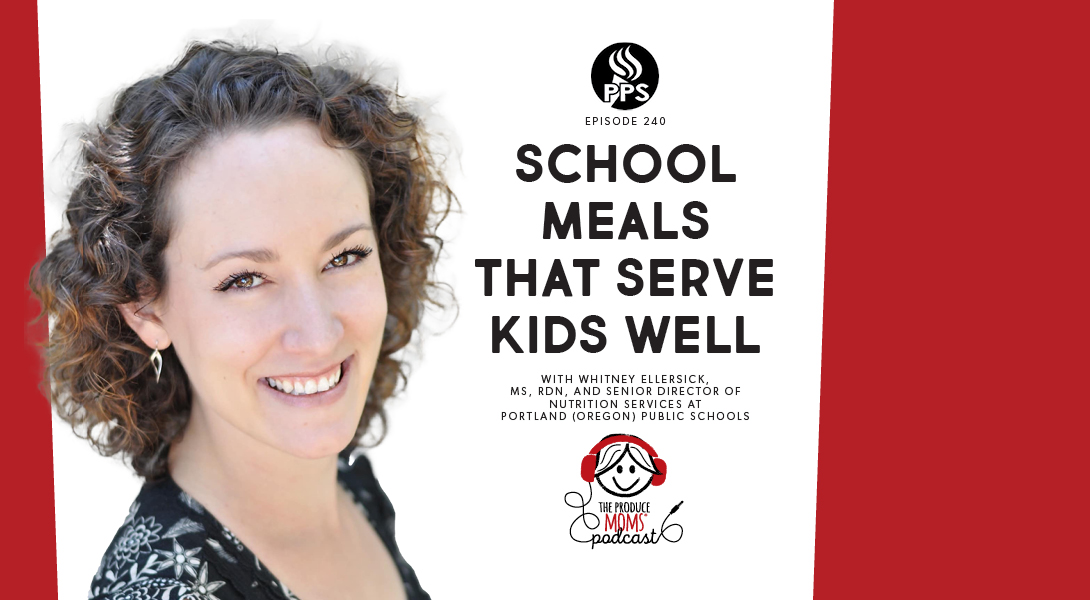
This post may contain affiliate links. Please read our disclosure policy.

We’re a huge advocate for school meal programs at The Produce Moms, because these are an incredible way for kids to connect with the culture and local agriculture behind their fruits and vegetables. It’s also a great opportunity for them to gain exposure to new foods they might not have access to at home or feel inspired to try something new thanks to one of their peers. Whitney Ellersick, MS, RDN, and Senior Director of Nutrition Services at Portland (Oregon) Public Schools sat down with us to share the incredible impact they’re making on their students’ lives by serving them innovative menus filled with locally sourced produce and scratch made meals. Whitney has been recognized by the Food Service Magazine’s 30 Under 30, as Oregon’s Academy of Nutrition and Dietetics Young Dietician Of The Year, and one of her school lunches was named the best school meal in America!
One of the really incredible things about the nutrition services programs Whitney has helped spearhead is how they’re taking their federal funds and reinvesting them back into the local economy. Whitney’s been able to work with many parents of students who are in the supply chain by partnering with them or buying with them, making it a full circle for their hard work to come back to their children through school lunches or after school snacks and suppers. For example, there’s a Japanese immersion school in Portland’s school district and by consulting with these students’ parents, Whitney was able to come up with a healthy, yakisoba noodle lunch that was named one of the best meals in America! Even parents were coming to have lunch with their children when they first started serving it.
Since the school district didn’t have their own operational support for the yakisoba noodles, she reached out with a local vendor who was able to develop noodles that used Oregon-grown grains and met the requirements for national school lunches. “It also was a great vehicle for adding in vegetables. We are adding in shredded cabbage, shredded blend of carrots to add that texture and crunch, and in some cases, we’re roasting mushrooms and tossing those in too.”, says Whitney.
Now other school districts in the state have seen the success Portland has had and they’re looking into how they can serve this too. The Portland School district serves 30,000 meals a day to 46,000 students across 92 locations, including breakfast, lunch, snacks and (for certain programs) after school programs. For the nutrition services to thrive, participation is key. Whitney and the rest of the nutrition services team have been able to serve kids meals that were made from scratch, locally sourced and come from an innovative menu, but that wouldn’t be possible without families and staff also eating up their delicious meals. There’s a big push for school lunches to be free to everyone, because every student, staff member and family should feel comfortable eating with them, regardless of their economic status.
“We want school meals to be a universal free offering in the same way school transportation, textbooks and other services are offered as standard free offerings within the school environment.” Lori Taylor (19:09-19:19)
Not only are they focused on serving healthy, locally sourced meals across the Portland school district, but doing so in a quick, efficient manner. One of the biggest reasons students may choose to not eat a school lunch is because they don’t want to wait in line or waste their precious time taking a break or socializing during lunch period. We’d say they’re doing a pretty good job, however, considering at one high school they served 721 students in just 20 minutes! Whitney and the team want the students to enjoy their lunch period as long as possible, because the face-to-face interaction is so important to their social skills, builds culture, and gives students an opportunity to try a fruit or vegetable they see a peer eating, which they might otherwise turn away.
School districts are required to serve five different components at lunch time: fruits, vegetables, whole grains, lean proteins and milk. A half cup of fruit needs to be offered to younger students, and a full cup to high school students. Vegetables are broken down into different subgroups including legumes, dark, leafy greens, starchy vegetables, red and green vegetables, and an “other” category.
Since pears are Oregon’s state fruit, students are presented with a plethora of opportunities to enjoy this delicious, locally sourced piece of produce! One fun way the schools have recently introduced pears to students is through a kale salad. They’ve massaged the kale in a scratch-made balsamic or sesame soy dressing and sliced fresh pears up in the salad. This was a great way to give students the opportunity to try different combinations of foods, not just a typical fruit salad. Pears have also been roasted sprinkled with granola on top for a fruit-based treat that’s lower in added sugar and filled with plenty of nutrients. Whitney has worked hard with each school’s kitchen team to teach them how to prepare and serve pears, and also empower them to make the right decision if, for example, a piece of produce isn’t ripe. Serving kids a piece of unripe pear is a missed opportunity for them to fall in love with that piece of produce, when if it was just left to ripen for a day or two longer, it could be their new, favorite piece of produce.
Whitney and the Portland school district has done a great job of serving students plenty of opportunities to try multiple types of fruits and vegetables, whether it’s during their regular school lunch, as an after-school supper during an enrichment program, or during summer school. As Whitney and Lori both said, it can be much more impactful for a child to see one of their friends or peers eat a piece of produce they might’ve not tried before than one of their parents.
If you’re a parent, Whitney wants to remind you to not give up! Even her own kids, the children of a dietician mom and a dad who’s a chef, have been more influenced by their peers. She suggests getting your kids involved when you’re going grocery shopping and letting them pick out a piece of produce based on its shape or color, having them cut their next pear or pepper up themselves, inviting them to help prepare your fruits and veggies, and giving them opportunities to plate their food themselves. If kids are able to grow, cook or touch their food, they’re much more likely to try it, and hopefully enjoy it!
How to get involved
- Join The Produce Moms Group on Facebook and continue the discussion every week!
- Reach out to us – we’d love to hear more about where you are in life and business! Find out more here.
Previous episodes you may enjoy
- Episode 239: Brittain Ladd
- Episode 238: Lori Castillo
- Episode 237: Katherine Sizov, Jay Jordan, and Shebaz Singh
- Episode 236: Rick Nahmias and Nkemdilim Nwosu
- Episode 235: Seth Goldman
- Episode 234: Turner Wyatt
If you liked this episode, be sure to subscribe and leave a quick review on iTunes. It would mean the world to hear your feedback and we’d love for you to help us spread the word!
